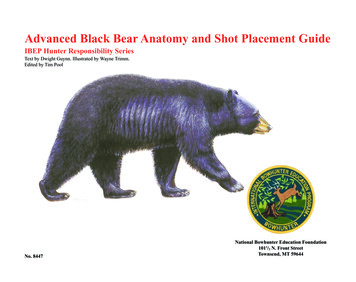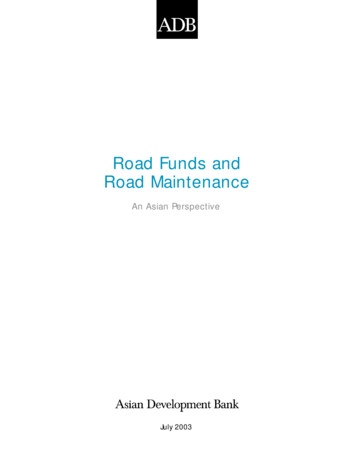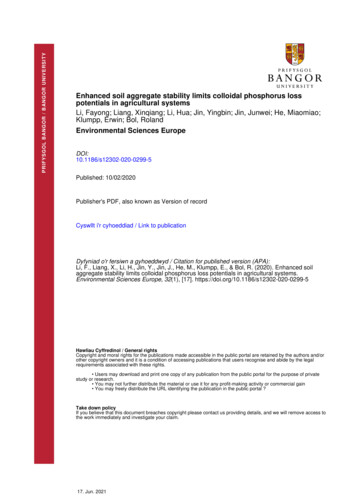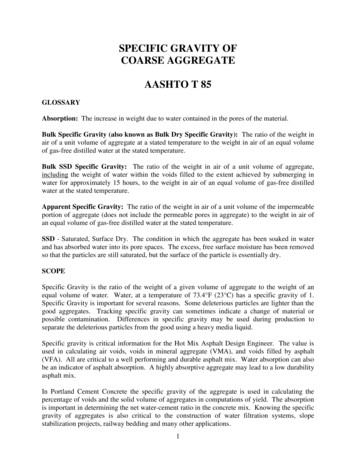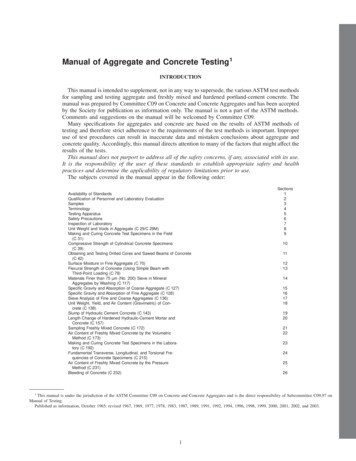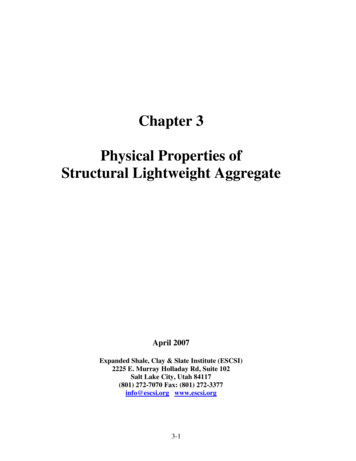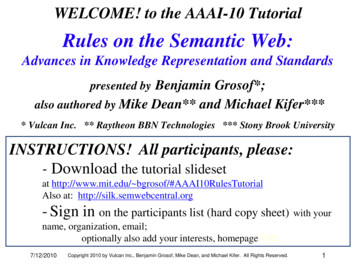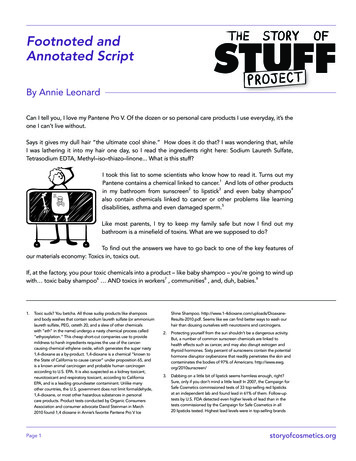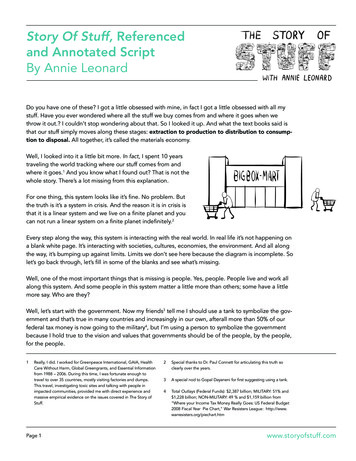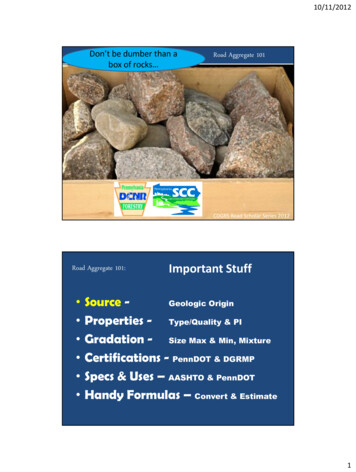
Transcription
10/11/2012Don’t be dumber than abox of rocks Road Aggregate 101CDGRS Road Scholar Series 2012Road Aggregate 101: Important StuffSource Geologic OriginProperties - Type/Quality & PIGradation - Size Max & Min, MixtureCertifications - PennDOT & DGRMPSpecs & Uses – AASHTO & PennDOTHandy Formulas – Convert & Estimate1
10/11/2012Road Aggregate 101:Source or Geologic OriginTYPICAL ROAD AGGREGATE MATERIALS INPA LimestoneLimestone Sandstone Bankrun GravelSandstone(Pit Run) ShaleBankrungravel(mud-rock)Road Aggregate 101:Source or Geologic OriginTYPICAL ROAD AGGREGATE MATERIALS INPA Limestone Sandstone Bankrun Gravel(Pit Run) NDSTONELIMESTONEBANKRUN?Thumb rule. There are exceptions.2
10/11/2012Road Aggregate 101: Important StuffSource Geologic OriginProperties - Type/Quality & PIGradation - Size Max & Min, MixtureCertifications - PennDOT & DGRMPSpecs & Uses – AASHTO & PennDOTHandy Formulas – Convert & EstimateRoad Aggregate 101:Properties of Type/QualityPennDOT Aggregate Types A,B & C1231 - Soundness (PTM No. 510) - This test method furnishes information helpful in judging the durability of an aggregate whensubject to weathering action.2 – Abrasion (AASHTO T-96) - Resistance of a Smaller Sized Aggregate to Degradation by Abrasion and Impact using the LosAngeles Machine. A test of “hardness,” or the relative ability to resist traffic wear.3 – Unwanted Junk – Maximum allowable amount by weight of undesirable material for road related purposes.3
10/11/2012Road Aggregate 101:Property of PlasticityPlasticity Index (PI) The plasticity index (PI) is a measure of the plasticity of a soil. Soilswith a high PI tend to be clay, those with a lower PI tend to be silt,and those with a PI of 0 (non-plastic) tend to have little or no silt orclay¹. 0 - Nonplastic (1-5)- Slightly plastic (5-10) - Low plasticity (10-20)- Medium plasticity (20-40)- High plasticity 40 Very high plasticityWatch for signs of high clay content –“Your eye doesn’t lie”1) http://en.wikipedia.org/wiki/Atterberg limitsRoad Aggregate 101:Property of PlasticityPlasticity Index (PI) If the fines are sticky, or cause the larger particles to stick together, the fines areprimarily clay.Try to make a thread – Take approx 1 cubic inch of soil and work it into a thread(mix it with a small amount of water if needed).– If it is very difficult or impossible to roll a thread, the mix is low plasticity.– If you can easily roll a thread, the mix is moderately plastic.– The mix is highly plastic if it is very stiff, but you can roll a thread. But the only way to really know is to have the aggregate lab tested!DCNR has adopted a maximum PI of 6For their DSA specification. The Centeris reviewing this specification changefor the DGRMP. More to come 4
10/11/2012Road Aggregate 101: Important StuffSource Geologic OriginProperties - Type/Quality & PIGradation - Size Max & Min, MixtureCertifications - PennDOT & DGRMPSpecs & Uses – AASHTO & PennDOTHandy Formulas – Convert & EstimateRoad Aggregate 101:Gradation or distribution ofdifferent sized stones5
10/11/2012Road Aggregate 101:Gradation – size does matter!Determined by sieve analysis and washingMaterial Finer than the 75 μm (No. 200)Sieve. Determine the loss by washingaccording to PTM No. 100Road Aggregate 101:Reported on table or chartGradation or distribution ofdifferent sized stonesFrom PennDOT Publication 408, Section 703 .2 – Coarse AggregateThe AASHTO system ranks specs according to size (1-10), with 1 being the largest (all material must pass a 4” sieve) and 10being the smallest (all material passing a 3/8” sieve). Multi-digit specs represent a blend of one or more of the ten basicspecs (i.e. AASHTO 57 is a blend of AASHTO 5 and AASHTO 7). AASHTO Specifications are technically open graded aggregate.6
10/11/2012Road Aggregate 101:Nominal maximum and/orminimum sized stone in mixThe nominal size distribution of an aggregate specification is defined asthe range of sieve openings through which 100% of the aggregate canpass.Road Aggregate 101:Gradation or distribution ofdifferent sized stonesOpen graded aggregate vs. well graded aggregate.What’s the difference?Open GradedWell GradedDrains Well, Displaces EasilyCompacts Well, Maintains Shapegood base or sub-basegood surface aggregate7
10/11/2012Road Aggregate 101: Important StuffSource Geologic OriginProperties - Type/Quality & PIGradation - Size Max & Min, MixtureCertifications - PennDOT & DGRMPSpecs & Uses – AASHTO & PennDOTHandy Formulas – Convert & EstimateRoad Aggregate 101:Material Certification - PADOTA PennDOT certified lab technician attests that the product meets Penn DOT Pub. 408,Section 703 requirements for Gradation and Properties.8
10/11/2012Road Aggregate 101:DSA Certification - DGRMPPennDOT certified lab tech attests that the DSA delivered meets DGRMP specifications.Note: On Dirt and Gravel Road Program projects, a certification must accompany thefirst load of DSA delivered to the worksite on each day. Use the DGRMP certificationform for DGRMP projects. Collect this form and retain for records.Road Aggregate 101: Important StuffSource Geologic OriginProperties - Type/Quality & PIGradation - Size Max & Min, MixtureCertifications - PennDOT & DGRMPSpecs & Uses – AASHTO & PennDOTHandy Formulas – Convert & Estimate9
10/11/2012Road Aggregate 101:Specifications and UsesA rock by a different name:Gravel – unconsolidated rock fragments formed as a result of the weathering and erosionof larger rocks. PennDOT requires gravel used for road construction to be durable with aminimum of 85% crushed particles and at least two faces resulting from fracture.Stone - a piece of rock quarried and worked into a specific size and shape for a particularpurpose. PennDOT requires that stone be durable and free from slate texture or cleavageplanes.Sand – Mined or manufactured rock particles predominately smaller than 3/16”.Aggregate – a mixture of specific types and sizes of crushed rock or gravel. Generally usedwith a binder in pavements. Also used as road base and sub-base.Rip-Rap – a loose assemblage of large stones (rubble). Often used for erosion control andstabilization of roadside features, or as road sub-base on soft ground.AASHTO – American Association of State Highway and Transportation OfficialsRoad Aggregate 101:Common Specifications & UsesName:AASHTO 1 (PA #4 or Ballast)AASHTO 3 (PA 3A)AASHTO 57 (PA 2B)AASHTO 8 (PA 1B)AASHTO 10 (Grit, Screenings)PennDOT 2A (2A Modified)PennDOT 2RC (Reclaim, Misc)PennDOT 3A (3A Modified)PennDOT Anti-Skid Type IIDSA (DGRMP Developed)TSA (DGRMP Developed)Use:Road Base, Buried DrainsRoad Base, Haul SurfaceBuried DrainsChip SurfacingTrail SurfaceRoad Base, Road SurfaceFill, Bedding, Road SurfaceHaul Road Surface, ChokeWinter TractionRoad SurfaceTrail Surface10
10/11/2012Road Aggregate 101:Common Specifications & UsesIf you prefer tables instead Don’t strain your eyes!This is in the hand-out.Road Aggregate 101:Rip-Rap Sizes and UsesName:Average ”*Surge10”- dust*Gabion (clean) 4”-8”*Shot Rock24”Use:Bridge AbutmentsStreambank (14.5’/sec)Streambank (13’/sec)Streams (11.5’sec)/DitchesDitches, Not StreamsSub-grade StabilizationFill, Sub-grade StabilizationBaskets, Ditches, DiffusersBridge Abutments Will vary by location/supplier. Surge is 1st run material off the crusher. Gabion is clean/washed material within asize range. Shot Rock is unprocessed rubble from the quarry wall (select sized/shaped stones can be harvested).11
10/11/2012Road Aggregate 101:Rip-Rap Sizes and UsesMust be well graded, hard and angular rock with no seams. Neither the rock widthnor the thickness can be less than one third its length.Road Aggregate 101: Important StuffSource Geologic OriginProperties - Type/Quality & PIGradation - Size Max & Min, MixtureCertifications - PennDOT & DGRMPSpecs & Uses – AASHTO & PennDOTHandy Formulas – Convert & Estimate12
10/11/2012Road Aggregate 101:Handy Formulas forField and OfficeConverting cubic yards to tons of:Large Open Graded Aggregate (AASHTO 1, Rip-Rap) yd³ x 1.4Well Graded Aggregate (2A, 2RC) yd³ x 1.5Driving Surface Aggregate or TSA yd³ x 1.55Shale yd³ x 1.35Topsoil /Dirt yd³ x 1.2Quick formulas for estimating tonnage of DSA required:For 6” loose lift compacted to 4 ½ “ Rd Length’ x Rd Width’ x .029For 8” loose lift compacted to 6” Rd Length’ x Rd Width’ x .038Road Aggregate 101:But the plancalled forAASHTO 1and 2A?We put downnumber 4sand topped itwith modifiedI hateaggregate!13
10/11/2012Road Aggregate 101:Rock of different sizes, differentmixtures and different names fordifferent uses. Simple! Right?Road Aggregate 101:THE ENDPlease submit all questions to theBrian Trust 14
Must be well graded, hard and angular rock with no seams. Neither the rock width nor the thickness can be less than one third its length. Road Aggregate 101: Important Stuff Source - Geologic Origin Properties - Type/Quality & PI Gradation - Size Max & Min, Mixture Certifications - PennDOT & DGRMP Specs & Uses – AASHTO & PennDOT

